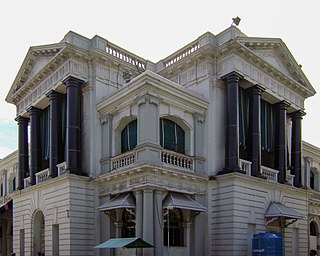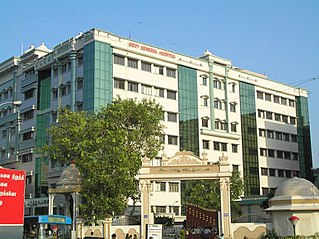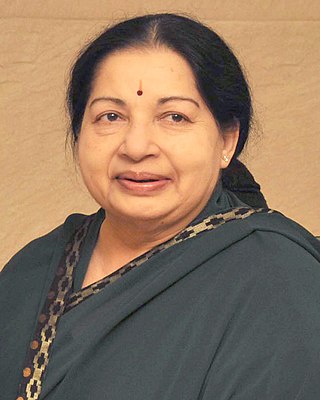
Fort St. George is a fortress at the coastal city of Chennai, India. Founded in 1639, it was the first English fortress in India. The construction of the fort provided the impetus for further settlements and trading activity, in what was originally an uninhabited land. Thus, it is a feasible contention to say that the city evolved around the fortress. The fort currently houses the Tamil Nadu legislative assembly and other official buildings.

Koyambedu is a neighbourhood in Chennai, India. Situated in the western part of Chennai city, the Koyambedu area has become a major hub of activity in Chennai after the inauguration of the Koyambedu market in 1996 and the Chennai Mofussil Bus Terminus (CMBT) in 2002. The area is active round the clock owing to the movement of people and goods through the day, with uninterrupted transport facilities such as long-route buses, autos, share autos, vegetable goods carriers and so forth.

Chepauk is a locality in Chennai, India. The name Chepauk is popularly used to refer to the M. A. Chidambaram International Cricket Stadium, also known as the Chepauk Stadium. It is also home to the Chepauk Palace, built in the Indo-Saracenic style. The University of Madras campus is yet another prominent landmark of Chepauk. The Central Research laboratory is located here. Chepauk's postal index number (PIN) code is 600005. The main roads of Chepauk are Bells Road and Walajah Road.

Jawaharlal Nehru Stadium is a multi-purpose stadium in Chennai, India. The stadium is located at Sydenhams Road in Park Town besides the Chennai Central suburban railway station. It has a capacity of 40,000.

Rajiv Gandhi Government General Hospital is a major state-owned hospital situated in Chennai, India. The hospital is funded and managed by the state government of Tamil Nadu. Founded in 1664 by the British East India Company, it is the first modern hospital in India. In the 19th century, the Madras Medical College joined it. As of 2018, the hospital receives an average of 12,000 outpatients every day.

The Tamil Nadu Legislative Assembly is the unicameral legislature of the Indian state of Tamil Nadu. It has a strength of 234 members, all of whom are democratically elected using the first-past-the-post system. The presiding officer of the Assembly is the Speaker. The term of the Assembly is five years, unless dissolved earlier.

The Fourteenth legislative assembly election was held on 13 April 2011 to elect members from 234 constituencies in Tamil Nadu. Results were released on 13 May 2011. Two major parties Dravida Munnetra Kazhagam (DMK) and All India Anna Dravida Munnetra Kazhagam (AIADMK) faced the election as coalitions of multiple parties with the DMK front consisting of 8 parties and the AIADMK of 11 parties. AIADMK front won the election, winning in 203 constituencies, with the AIADMK party itself winning 150 seats thus securing a simple majority to be able to form the government without the support of its coalition partners.

Chetpet lake is a lake spread over 16 acres in Chetput, Chennai, India. It is located to the north of Chetpet railway station. It is the only existing lake at the centre of the city. The lake belongs to the Department of Fisheries of the Tamil Nadu government.

Healthcare in Chennai is provided by both government-run and private hospitals. Chennai attracts about 45 percent of health tourists from abroad arriving in the country and 30 to 40 percent of domestic health tourists. The city has been termed Health Capital of India. Multi- and super-specialty hospitals across the city bring in an estimated 150 international patients every day. Factors behind the tourists' inflow in the city include low costs, little to no waiting period, and facilities offered at the speciality hospitals in the city.

Arignar Anna Alandur Metro, commonly known as the Alandur Metro, is an elevated metro station that is part of the Blue Line and the Green Line of the Chennai Metro, and serves as an interchange station between the two lines. The station is one of the two metro stations where the two lines intersect, the other being the Chennai Central metro station. It is the city's first multi-level railway station. It is the only station where passengers from the two corridors can swap the direction of travel. On 31 July 2020, It has been named by Government of Tamil Nadu as Arignar Anna Alandur Metro to honor the DMK founder and the former Chief Minister of Tamil Nadu C. N. Annadurai.

M.G.R. and Amma Memorial, officially Bharat Ratna Puratchi Thalaivar Dr. M.G.R. and Puratchi Thalaivi Amma Selvi J. Jayalalithaa Memorial, is a memorial complex dedicated to the former chief ministers of Tamil Nadu M. G. Ramachandran (M.G.R.) and J. Jayalalithaa (Amma), where a black marble platform was raised on the spot of M.G.R.'s cremation on 25 December 1987, and on the spot of Jayalalithaa's on 6 December 2016. Both cemeteries consist of an eternal flame and a portrait of them at one end. A stone footpath leads to the lotus-shaped wall enclosure that houses the M.G.R. Memorial, with the sword pillar topped with a spherical-shaped dome light, and a stone footpath leads to the phoenix-shaped wall enclosure that houses the memorial of M.G.R.'s protégé and the former chief minister of Tamil Nadu J. Jayalalithaa. The memorial complex is located on Kamarajar Promenade, adjacent to the Anna Memorial on the Marina Beach in Chennai, Tamil Nadu, India.
Tamil Nadu Government Dental College, also known as Government Dental Hospital and College, is the dental wing of the Madras Medical College. Although the college is a separate entity administratively, it is functionally integrated with the Madras Medical College and Government General Hospital.
Government Royapettah Hospital is a major state-owned hospital situated in Royapettah in Chennai, India. The hospital with 712 beds is funded and managed by the state government of Tamil Nadu. It was founded in 1911 and is attached to Directorate of Medical Education. It is the city's largest peripheral hospital, and its limit extends up to Chengalpattu.
Southern Railway Headquarters Hospital, also known as the Perambur railway hospital, is a 500-bed hospital of the Southern Railway located in Ayanavaram, Chennai. It is spread across a land measuring 15 acres (6.1 ha) and was established during the British rule in India. The hospital has specialized in 15 basic disciplines and super-specialized in 3 disciplines. The National Board of Examination (NBE) has accredited the hospital for recognition in postgraduate training. The hospital has also been accredited by international institutions such as Royal College of Surgeons for imparting training in PG courses. It is also an approved institution for training nurses.

CMBT Metro, officially known as Puratchi Thalaivi Dr. J. Jayalalithaa CMBT Metro, is an important elevated metro station on the South-East Corridor of the Green Line of Chennai Metro in Chennai, India, which will chiefly serve the Chennai Mofussil Bus Terminus in front of the main facade. On 31 July 2020, It has been named by Government of Tamil Nadu as Puratchi Thalaivi Dr. J. Jayalalithaa CMBT Metro to honor the former Chief Minister of Tamil Nadu J. Jayalalithaa, who inaugurated the Puratchi Thalaivar Dr. M.G.R Bus Terminus, Asia's biggest bus terminus and the metro station.
Namakkal Kavignar Maligai is an 11-storied building at the Fort St. George campus in Chennai, India, serving as the power centre of state secretariat of Tamil Nadu. It is the only skyscraper built within the Fort campus. As of 2014, there were about 6,000 staff at the secretariat.

Government Sivagangai Medical College and Hospital was started in 2012-13 in the Sivaganga district with an annual intake of 100 students for MBBS Course. The college was approved by Medical Council of India and it is affiliated to Tamil Nadu Dr. M.G.R. Medical University, Guindy, Chennai.

The 2015 Chennai floods resulted from heavy rainfall generated by the annual northeast monsoon in November–December 2015. They affected the Coromandel Coast region of the South Indian states of Tamil Nadu and Andhra Pradesh. More than 500 people were killed and over 1.8 million people were displaced. With estimates of damages and losses ranging from nearly ₹200 billion (US$2 billion) to over ₹1 trillion (US$12 billion), the floods were the costliest to have occurred in 2015, and were among the costliest natural disasters of the year.
Wallajah Road in Chennai, Tamil Nadu, India branches off from Anna Salai. It is one of the major link roads in Chennai, connecting Anna Salai and Rajaji Salai, Chennai. It starts from the Arignar Anna Statue and reaches Marina Beach at Rajaji Salai. The new State guest house being constructed in Omandurar Government Estate is nearing completion in February 2016.
The Madras Record Office, currently known as Tamil Nadu Archives (TNA), is located in Chennai and is one of the oldest and largest document repositories in Southern India. Documents stored and archived in TNA are invaluable to researchers working on post-independence Tamil Nadu or British-era Madras Presidency. In addition to British India records, TNA also houses a substantial collection of Dutch East India Company records from the late-seventeenth and eighteenth centuries and volumes relating to various southern Princely States.

















